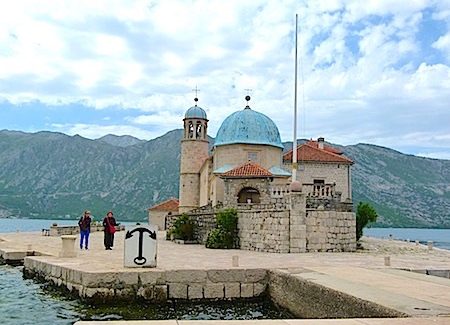Adding stones to Our Lady of the Rocks
Two brothers returning from a voyage on July 22, 1452, were surprised to find an icon of the Virgin Mary and baby Jesus on a small rock in the middle of the sea.
“They believed it was a miracle and said they would build an island with an altar to honor the icon,” said tour guide Diana. “They started bringing stones here and that is how we got this small island.”
It took almost 200 years for the tiny “island” known as Our Lady of the Rocks to be built. It is the only artificially built island in the Adriatic. Over centuries, the island has been constantly enlarged and reinforced by both deposits of stones and scuttled sailing ships.
Before we boarded out shuttle boat to the island, program director Antun Matičević told us to find a small rock to take with us. Once we arrived on the island, Antun had us ceremoniously stand in a line and throw our stones into the sea.
“We need to do our share to help the island stay here,” he said, as our small rocks dropped over the edge of the island. Sailors are a superstitious lot, Antun said, and they bring rocks to keep the island afloat and also to thank the Virgin Mary for safe passage.
In fact, once a year on July 22, people of the Bay of Kotor deliver stones to the island at sunset and lay them in the depths. The event is called Fašinada. A sailing regatta also takes place during the day.
“The first known church was built on the islet in 1452,” Diana said. “The present Church of Our Lady of the Rocks was built by Roman Catholics in 1632.”
Inside the church are 68 paintings by a famous 17th century baroque artist named Tripo Kokolja. Other famous paintings also are here as is a treasured icon created about 1452 by Lovro Dobriečevič.
“The biggest treasures are silver plates, 2,000 silver plates, the biggest collection in the world,” Diana said. “Sailors and other people pray to the Virgin Mary and if their prayers are answered, they come here with a silver plate. Or if they are making a request, they bring a silver plate here. The newest plate here is six months old. It is still a Roman Catholic Church and miracles still do happen.”
The silver votive tablets come in all sizes and shapes and often contain a representation of a body part or an item to symbolize something that needs holy help. Called “tama,” the metal plates could have a pair of eyes engraved to indicate an eye affliction; a heart, a leg or hand for problems with those body parts or a pair of wedding crowns requesting a prayer for a happy marriage.
“People often get married here and they leave something for a gift and to request a blessing on the marriage,” Diana said, gesturing to a large group of fading bridal bouquets and floral tiaras hung over a church door.
Adjoining the church is a small museum with gifts for prayers answered or prayers requested. It would be fascinating to know the stories behind the ship lights, ropes, engraved ship head, photos and even a rock painted with the ship name for Azamara Quest, along with a drawing of the ship, the date Sept. 17, 2010, and the name Capt. Carl Smith.
There is also a small gift shop close to the church and a navigation light at the western end of the islet.
Among all the interesting items is a large tapestry embroidered by Jacinta Kunić-Mijović of Perast. It took her 25 years to finish it while she waited for her darling mariner to return from a long ocean journey.
“She used gold and silver fibers and her own hair for some of the thread in the tapestry. You can see her hair slowly change colors over the years from black to white,” Diana said. “As she embroidered the tapestry, she would pray. It is a symbol of love and devotion. She finished the tapestry in 1828. But her husband never did return.”
Story and photo by Jackie Sheckler Finch















View Recent Comments